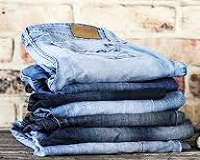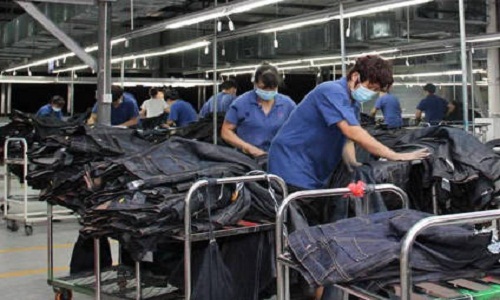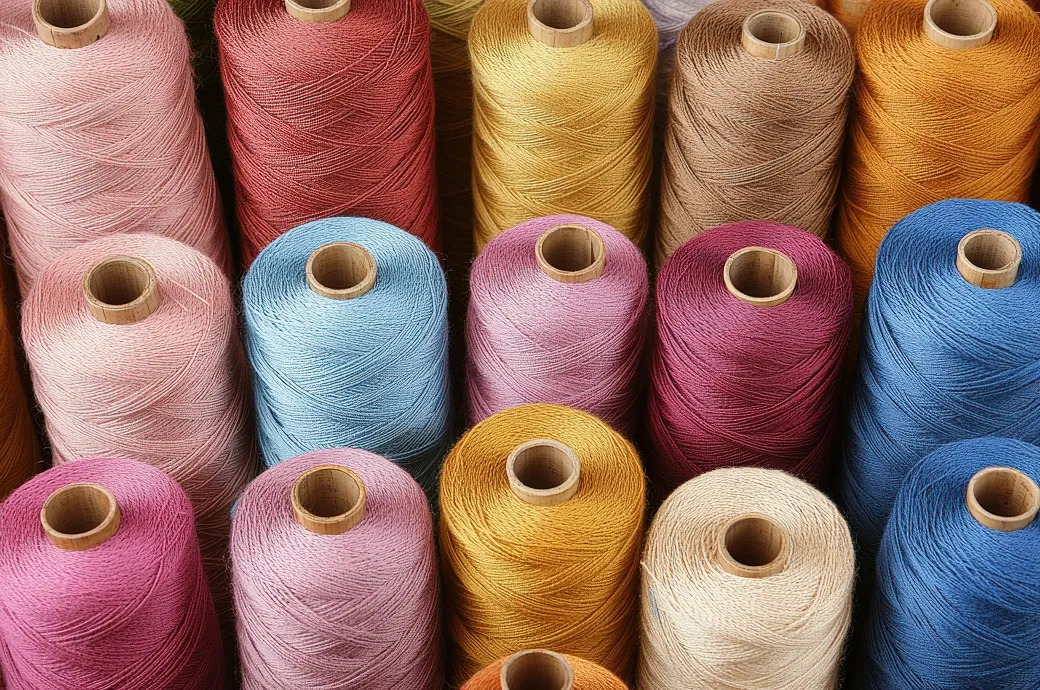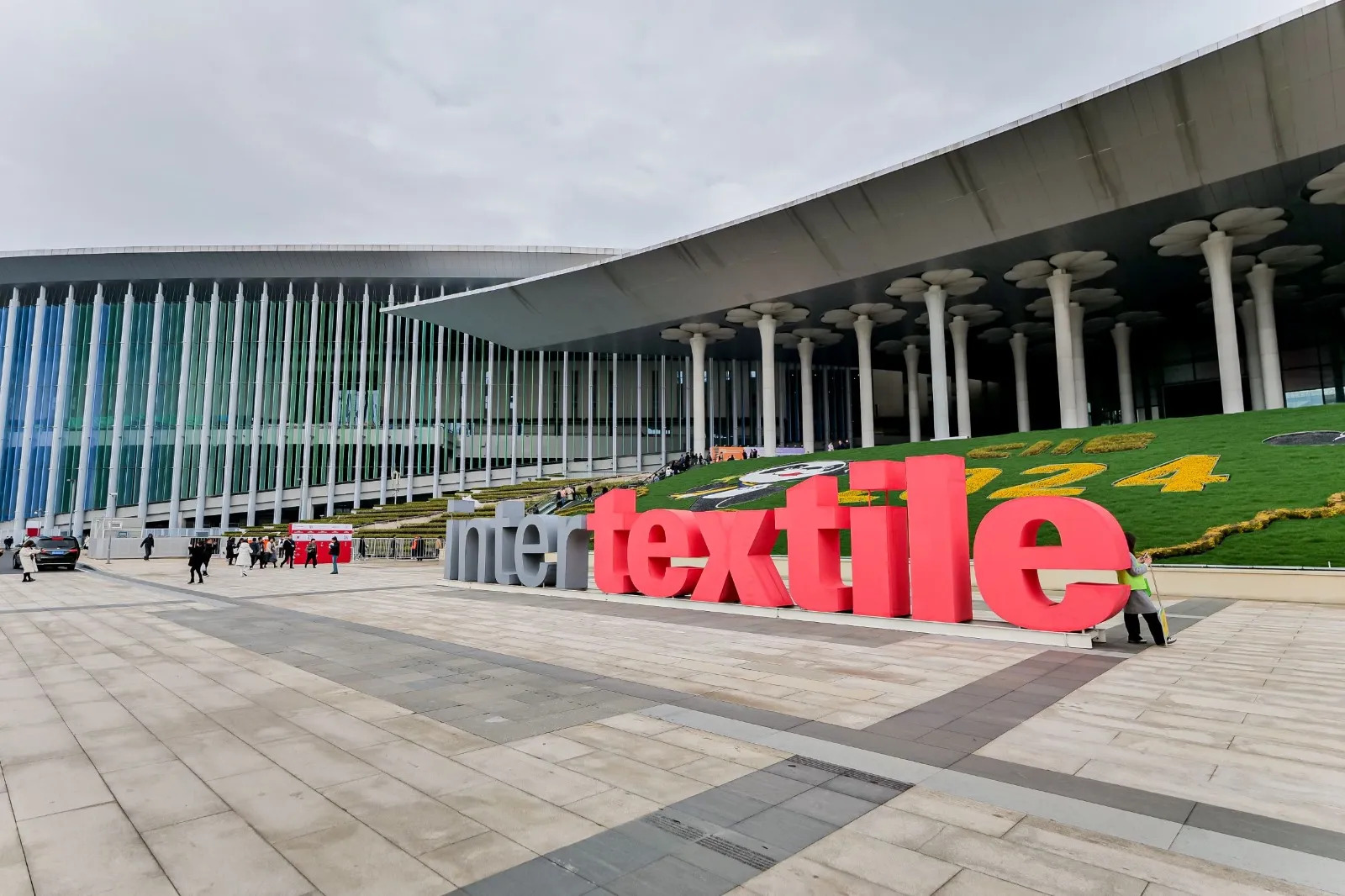FW
"An average consumer buys four pairs of jeans a year in the US; in China’s Xintang province, a hub for denim, 300 million pairs are made annually. These figures could illustrate the harmful impact of denim manufacturing on the environment. And showcasing these effects, award-winning filmmakers David McIlvride and Roger Williams, have created a new documentary film, ‘The RiverBlue: Can Fashion Save the Planet?’ It is estimated that 70 per cent of Asia’s rivers and lakes are contaminated by the 2.5 billion gallons of wastewater produced by that continent’s textile industry."

An average consumer buys four pairs of jeans a year in the US; in China’s Xintang province, a hub for denim, 300 million pairs are made annually. These figures could illustrate the harmful impact of denim manufacturing on the environment. And showcasing these effects, award-winning filmmakers David McIlvride and Roger Williams, have created a new documentary film, ‘The RiverBlue: Can Fashion Save the Planet?’ It is estimated that 70 per cent of Asia’s rivers and lakes are contaminated by the 2.5 billion gallons of wastewater produced by that continent’s textile industry. In scene after scene, the dark frothy spill off can be seen rushing out of dye facilities while a cadre of scientists and environmental experts detail the public health crisis that has resulted from the largely unregulated manufacturing process.
Loads of chemicals & counting

To get the desired look, denim is subjected to several chemical-intensive washes. Campaigners from Greenpeace, who tested the outflows near dyeing and finishing facilities in top denim producing towns of Asia, found five heavy metals (cadmium, chromium, mercury, lead and copper) in 17 out of 21 water and sediment samples taken from throughout Xintang one of the locales featured in the project. Toxic campaigners in China also discovered heavy metals like manganese, which can be associated with brain damage, in the rivers. These chemicals don’t stay put. They can also be transported to North American oceans, atmosphere and food chains and accumulate in places far away from their original source.
The change agent
The film poses a very pertinent question to viewers: Are brand-name clothing corporations disregarding the environment in their zeal to make clothes faster and cheaper for consumers? Offering a solution, the film illustrates through innovation and consumer education there can be change. In California, a designer was trying to re-establish himself as manufacturer of good jeans when director David McIlvride found him. He narrated an incidence that he led them to the Spanish company, Jeanologia where they distress jeans by engraving images on the fabrics with lasers (light and air) and eliminating water without increasing the cost. They are now considered a leading industry innovator.
Jeanologia now creates technology to treat and finish jeans (giving them a certain feel or aesthetic). The company started searching for ways to make garments in a more sustainable way. They have been dyeing clothes with water since the beginning of time and faced the reality that even though it had been done this way in the mass consumer world, it was not sustainable, explained Alex Penadés, Jeanologia. Jeanologia developed several technologies using light and air to finish jeans using little water and no chemicals.
Using these innovations, an average pair of jeans requires just a glass of water to finish when it used to require 300 litres. However, it requires a big capital investment. Depending on the business model the capital investment is made by the dyeing and finishing facilities or brands. Jeanologia has Environmental Impact software to measure the footprint of every style and brands know where they are and how they can improve. Three years ago, about 16 per cent of the jeans in the world were made in a sustainable way he says. Now 35 per cent of jeans are made sustainably and about six billion pairs of jeans are made a year so that means two billion pairs are now being made in a more sustainable way.
According to Penadés, brands have a choice to manufacture in a traditional way or a sustainable way. The water and energy of traditional production is costly and so is pollution. Today, including the capital investment, you can produce the same product at the same price. Brands can do it. If the consumer is aware, they have to request these kinds of products today. Consumers must also know what their impact on the environment is because of their acts of consumption. It’s all about co-responsibility.
Welspun proposes to set up three manufacturing facilities in Telangana. Two of them would be dedicated to technical textiles, while the third would be for making pipes.
Welspun has a presence in home textiles, pipes, plates, coils, steel, infrastructure and energy. It is one of the largest home textile manufacturers in the world. In fiscal 2018, the company plans to expand its towel capacity from 72,000 metric tons to 80,000 metric tons. It will also invest in a new flooring facility.
Welspun’s next growth engine is flooring solutions, where it is investing heavily in over the next two years. The products include area rugs, carpets, carpet tiles, accent rugs and wall to wall carpets. Welspun has invested Rs 100 crores to set up a fresh state-of-the-art fully automated cut and sew unit in the made-ups segment with a capacity of 10 million units per annum.
Welspun is known as one of the most innovative companies in the home textile space, with a portfolio of 26 unique inventions across the globe, contributing 36 per cent to its sales.
Being India’s largest consumer of cotton, Welspun works with farmers at various cotton growing locations across the country to help them adopt better quality cotton crops. The company also guides and mentors farmers on right practices, seed and pesticides.
Vietnam hopes the Comprehensive and Progressive Agreement for Trans-Pacific Partnership (CPTPP) will enable it to boost exports to major markets such as Japan, Australia, Canada and Mexico. The CPTPP is a new free trade agreement between Australia, Brunei, Canada, Chile, Japan, Malaysia, Mexico, New Zealand, Peru, Singapore and Vietnam.
The agreement is also expected to provide opportunities for Vietnam to strengthen foreign direct investment in fields that the country seeks to develop. Vietnam’s garment and textile exports to CPTPP countries currently account for only 13 per cent of the total value, much lower than that of 38 per cent to the US market. Among the eleven member countries, Japan imports most of Vietnam’s garment and textile products, 8.8 per cent.
The garment and textile sector in Vietnam has also pinned its hopes on Australia and on increasing exports to this market. The agreement is also expected to provide additional opportunities for seafood exports. Japan currently is Vietnam’s largest seafood importer among CPTPP member countries, accounting for more than 15 per cent of Vietnam’s seafood export turnover. In addition, Mexico is a major tuna importer. In 2017, tuna export turnover to Mexico increased 66 per cent compared to 2016. With strong commitments to reduce tariffs, shrimp, tuna and octopus exports will benefit greatly from the CPTPP.
US manufacturers are developing advanced materials such as conductive fabrics with antistatic properties, electronic textiles that monitor heart rate and other vital signs, antimicrobial fibers, life-saving body armor, and fabrics that adapt to the climate.
There are a vast range of products offered by the industry, from burlap and cheese cloth, to industrial woven fabrics, to specialty fabrics for the aerospace manufacturing environment and beyond. US textile and apparel manufacturers shipped nearly $78 billion of products in 2017, exporting nearly $29 billion of materials to more than 200 countries worldwide.
Over the past three months, sourcing for fabrics is up 21 per cent over its historical average, sourcing in the category of industrial textiles is up eight per cent, and sourcing for textiles is up six per cent. This activity comes at a time when the US is focusing closely on trade, to level the playing field for US manufacturers against unfair trade practices from abroad – something that has hit the American textile industry hard in recent decades. Other factors playing into what many see as a resurgent US textile industry are low domestic energy costs, advances in automation, and a growing buy it, make it, ship it production model made possible by e-commerce.
Rachel Lund, Head of Insights and Analytics at the British Retail Consortium analysing latest UK labour market statistics says labour market figures confirm the retail industry is undergoing significant structural change. Despite the fact that the number of jobs in retail during the festive period was higher in 2017 compared to previous year, employment was down by 73,000 compared to Christmas two years ago and by more than 1,00,000 compared to ten years ago, in the midst of the financial crisis.
The reality is the economics of retailing are changing. Over the last two years, taxes on physical stores have grown by an estimated 8 per cent and employee wages by 10 per cent at the same time as overall sales have grown by less than 3 per cent and pounds spent on non-food products in physical stores have fallen by 5 per cent.
As a result, retailers are having to radically rethink how they operate in order to survive, investing more in technology and restructuring their store portfolios and workforce. While the result will raise productivity in the industry, the transition will not be painless and will affect some communities more than others.
Rupee appreciation in real terms has hurt Tirupur’s exporters, making it hard to compete on a cost basis with lower income countries such as Bangladesh. Bangladesh has already signed an FTA with the EU which has given it a 10.5 per cent cost advantage over India. Similarly, Vietnam is currently negotiating a free trade agreement with the EU and is already part of the Trans-Pacific Partnership.
While Tirupur’s exporters managed to overcome external shocks in the past, and ride through periods of slowdown such as the 2008 crisis, the cause of Tirupur’s pain this time is domestic policy. The combination of demonetisation and a hurried, faulty GST implementation has brought Tirupur to its knees.
Demonetisation completely decimated domestic demand by removing all liquidity from the market. GST has increased costs, not only of compliance but also of materials, services and working capital. Prior to GST implementation, the sum total of export incentives amounted to 13.65 per cent of FOB value. Subsequent to GST, this fell to eight per cent, a steep reduction of 5.7 percentage points.
Tirupur is India’s largest cotton textile export cluster. The tightening of liquidity for exporters has led to a contraction in demand for downstream processing units, leading to their inability to pay back loans on their capital.
A technical textile workshops will be held at Sardar Vallabhbhai Patel International School of Textiles and Management, Tamil Nadu from April 5 to 8, 2018. It’s meant for textile entrepreneurs in and around Tamil Nadu. Textile industries can work to enhance their products by value addition for the technical textile arena.
These workshops will be a platform to provide technical support, knowhow and the entire necessary infrastructure at one place. The workshops include three phases. The first phase would elaborate on various fields in technical textiles, product development, manufacturing processes and market. The second and third phase comprise planning and executing business plans on the technical textile sector.
Participants will undergo both theoretical and practical training including industrial visits. This sectoral training program will include sessions on medical textiles–products, manufacturing process, technology, machines, standards, market demand and marketing strategy.
Field visits will be arranged for participants to manufacturing and application sites to understand the practical aspects. Participants will also be provided with a questionnaire to conduct a survey at health care centers, medical textile product dealers and end users. Sessions on new product development, brain storming, SWOT analysis, discussions on intellectual property rights and new business startups have been planned.
The sectoral programs will cover agro textiles, home textiles, industrial textiles and packing textiles.
The Pakistan Readymade Garments Manufacturers & Exporters Association (PRGMEA) and Ecommerce Gateway Pakistan are jointly organising the three-day 19th Textile Asia 2018 - International Textile, Garments Machinery and Clothing Trade Fair from March 29 to 29, 2018 at the Karachi Expo Centre. PRGMEA chairman (Central) Shaikh Mohammad Shafiq disclosed the fair is expected to host over 2,000 foreign delegates as well as 65,000 visitors from the trade and corporate sector.
The focus is value addition in the textile industry to enhance export of value-added textile and garment products. This three-day trade fair is well known as South Asia’s biggest B2B textile, garment, embroidery, digital printing machines and chemical and allied services fair.
Over 1,000 International brands will showcase their products in 800+ booths and 2,000+ foreign delegates from 27 countries, including Austria, China, the Czech Republic, France, Germany, Italy, Korea, Japan, Turkey, the UK and the USA, will be present at the event.
Li Yang from the Department of Commerce of Zhejiang Province, China is the Guest of Honour. She is promoting Zhejiang Export Fair in Textile Asia for business, investment and joint venture opportunities. The PRGMEA chairman said Textile Asia is the only UFI (Paris) approved textile trade fair in South Asia which has immense buying selling potential of textile, garment and allied industries and is poised to introduce overseas suppliers of textile and garment materials, accessories and parts and machinery to the textile and garment industry of Pakistan. He complement their efforts for delivering high quality, value added products and promised to assist them in developing their export business.
Nike is the world’s most valuable label, according to Brand Finance’s annual top 50 rankings in apparel. The athletic giant retained its number one spot even after a tough year in North America. Nike is the world’s largest athletic apparel and gear maker. Nike’s gear is widely seen on courts and running trails, but the brand also has remained on-trend as part of the growing consumer interest in athleisure — a term that describes the growing acceptance of wearing athletic apparel and shoes just about anywhere.
However, steep competition to maximize on the sporting apparel trend, coupled with increased choice and information for the consumer could threaten Nike’s future position in the rankings. Adidas (up 41 per cent) played a key role in the struggles Nike has faced in the past two years, with the German-based sportswear brand seeing rapid growth across both sporting and casual categories.
Other notable brands that made the list: H&M, which once again inched past Zara for its number two spot as the Spanish fast-fashion competitor significantly narrowed the gap; Hermès, which overtook both Louis Vuitton and Gucci in the luxury fashion category (with Cartier as the biggest value winner, up 45 per cent); and rival Under Armour, which recorded the largest value drop in the set following its failure to capitalize on basketball shoes and other product verticals.
India has initiated an investigation into the import of jute sacking cloth from Bangladesh. There are allegations this is being done to evade anti-dumping duty on jute sacking bags. India has an anti-dumping duty on jute yarn/twine, hessian fabric and jute sacking bags brought from Bangladesh and Nepal.
The investigation would look to determine the existence, degree and effect of the alleged circumvention by poring through trade data from October 2016 to December 2017 and examine the need to extend the existing duty to the circumventing product.
Until investigations wrap up, Indian importers of jute products have been instructed to give an undertaking of payment of duty if their consignment of sacking cloth is found to be circumventing the existing tariff.
Exports of jute products have declined after India imposed the anti-dumping duty on jute products from Bangladesh. As a result, mills are sitting on increased stockpiles of jute goods. Bangladesh’s exports of jute and jute goods to India fell 18 per cent year-on-year in the July-February period of this fiscal year. During the period, shipment of jute bags fell sharply while exports of jute sacking cloth soared.
India accounted for 15 per cent of Bangladesh's total export receipts from jute and jute goods in the first eight months of the fiscal year.












